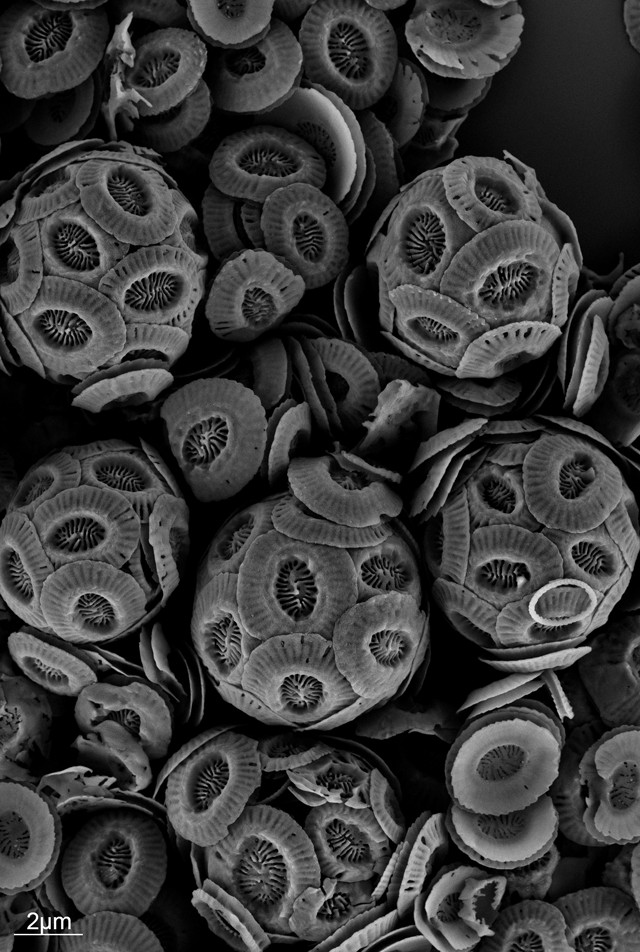
by Lucas Joel Friday, August 21, 2015

A scanning electron micrograph of the common coccolithophore Emiliania huxleyi. Credit: Elena Kartvelishvily and Daniella Schatz.
Microscopic phytoplankton, or microalgae, permeate ocean surfaces, sometimes forming huge blooms visible from space. Nutrient concentrations in seawater are known to regulate such blooms, which play a major role in oceanic food chains and carbon cycling, and occasionally prove harmful to other marine life as well as humans. Less understood are the other factors that influence a bloom’s onset and demise. New research sheds light on one such influence, demonstrating that an algae-infecting virus can become airborne and travel long distances, potentially infecting and eradicating parts of a bloom hundreds of kilometers away.
In a new study published in Proceedings of the National Academy of Sciences, scientists studied Emiliana huxleyi, a common, bloom-forming coccolithophore found the world over, as well as the E. huxleyi virus, or EhV, which can infect and kill E. huxleyi.
This virus infects entire blooms, “helping bring about [the blooms’] demise in an almost-synchronized manner,” says Assaf Vardi, a marine microbiologist at the Weizmann Institute of Science in Israel and a co-author of the study. “We wanted to know how the virus spreads and propagates over such large distances.”
To address one possible answer to this question, Vardi and Ilan Koren, an atmospheric physicist also at the Weizmann Institute, tested to see if EhV could leave the water and take to the winds as airborne particles. After growing E. huxleyi in a laboratory tank, the pair introduced EhV into the water, which subsequently infected the plankton. Then, they bubbled air through the water to observe what happened when bubbles burst at the surface. They found that, once the E. huxleyi in the tank were infected, EhV concentrations in the air increased, suggesting the bursting bubbles were acting like little sneezes, aerosolizing the viruses into the air above the water.
“Concentrations of EhV during peak infections in the water were very large — many millions of viruses per milliliter,” Koren says. “We didn’t expect to find so many virus particles being released to the air.” In the lab, the team found that EhV concentrations in the water reached a maximum of about 109 viruses per milliliter, and about 103 viruses per milliliter of air.
Once it became clear that EhV could become airborne, the next step was to see whether the virus could retain its infectiousness as an aerosol. The researchers linked the air outflow of the first tank to a new tank with uninfected E. huxleyi cells. “The viruses survived, settled back down into the water and infected the healthy culture,” Koren says. The team found that aerial virus concentrations as low as 10 to 100 viruses per liter of air were enough to lead to infection of the healthy cultures. After the healthy culture was initially exposed to the virus, it took three days before cell destruction occurred.
Vardi and Koren also detected airborne EhV when they collected air samples above an algal bloom during a research cruise in the North Atlantic in July 2012. Floating on ocean currents, viruses and other particulates can only travel about 1 kilometer per day, Koren says, but aloft in the air, “they can instead move hundreds of kilometers every few hours.”
Viruses are susceptible to damage from ultraviolet light and temperature changes in the atmosphere, and the researchers estimated that, under such conditions, only a small fraction of airborne EhV could remain viable over a long trip. In the lab, the team exposed EhV to damaging real-world conditions, and found that the virus has a half-life of about 20 minutes.
“But it only takes one” live EhV particle to infect a distant part of a bloom, says Emmanuel Boss, an oceanographer at the University of Maine who was not involved in the study. “This new work reveals a mechanism that helps explain why the virus seems to affect the whole bloom, and not just a corner of it.”
Identifying this dispersal mechanism will help scientists better model carbon cycling in relation to algal blooms, Boss says. “When a virus destroys an algal cell, the cell releases its carbon into the water, providing food for organisms like bacteria,” he says. “Now that we know the virus has a way of getting from one [part] of the ocean to another, we will need to change the way we model the flow of nutrients like carbon through ocean ecosystems.”
© 2008-2021. All rights reserved. Any copying, redistribution or retransmission of any of the contents of this service without the expressed written permission of the American Geosciences Institute is expressly prohibited. Click here for all copyright requests.